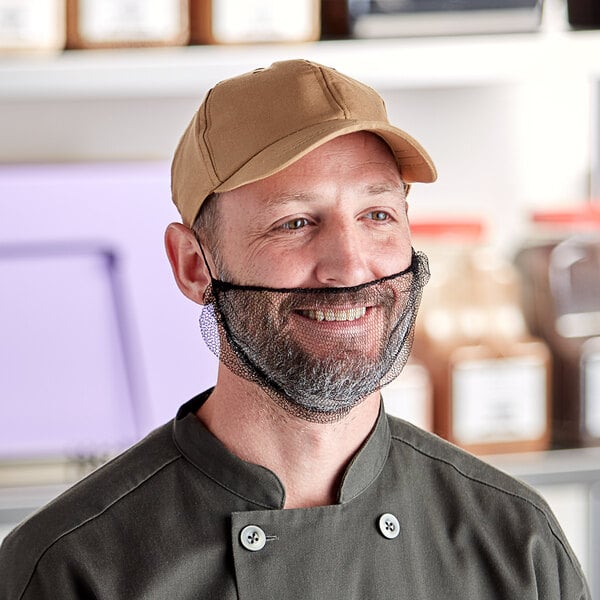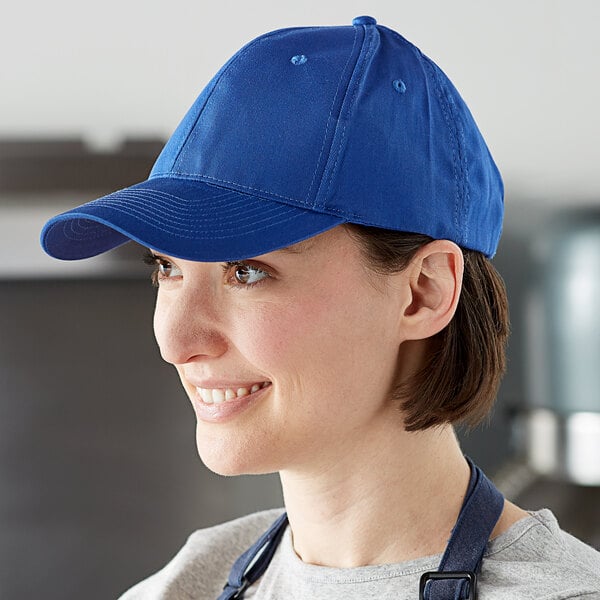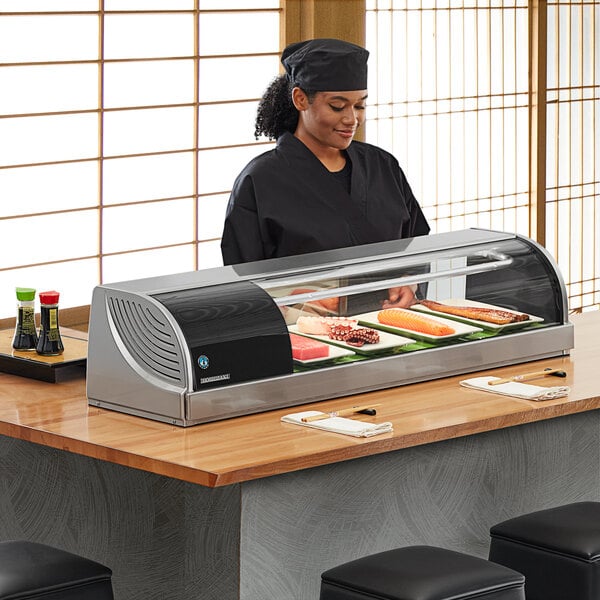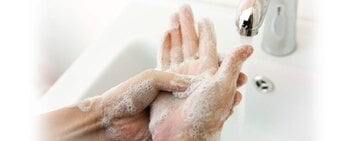
Hair Restraints for Foodservice
Shop All Hair Restraints
Foodservice Hair Restraints
Not only does hair negatively affect the perception of your establishment, but it can also cause a foodborne illness. Hair can be controlled in food preparation by covering it with a hair restraint. Below are the five most common types of hair restraints in foodservice establishments:

1. Chef Hat
If you operate a high-end or fine dining establishment, you may opt for a traditional chef hat to cover your kitchen staff's hair. They are made with cotton, polyester, and poly-cotton blend fabrics that are lightweight, breathable, and often moisture-wicking to ensure comfort throughout long shifts. Many chef hats feature an adjustable strap to fit various head sizes.
In addition to keeping hair restrained, chef hats complete a chef's uniform. There are several different chef hats to choose from, and some, like the toque hat, are used to denote seniority rank in the kitchen. However, the choice usually comes down to the restaurant's aesthetic and the types of chefs in the kitchen.

2. Hair Net
Ideal for high-volume cafeterias, fast casual restaurants, and grocery stores, disposable hair nets cover and mat down the hair to prevent loose strands from falling into contact with food or other important prep surface areas. They are typically made with a nylon or polyester mesh material and are the most affordable type of hair restraint.
Because of the mesh design, hair nets are breathable and comfortable to wear. However, the small openings could potentially allow hair to pass through. Just like disposable gloves, throw disposable hair nets away after using them or if they are damaged.

3. Beard Net
Food handlers with facial hair must wear a beard net while working. Similarly to hair nets, beard covers feature an elastic band that stretches to fit all beard and face sizes. They are also made with nylon or polyester mesh material for excellent breathability.
The beard length that requires a covering may be different from state to state. For example, Florida requires hair restraints for beards and mustaches longer than 1/2 inch. If you are unsure if your bearded employees need to wear a bear covering, you should confirm with your local health department.

4. Bouffant Cap
An excellent alternative to traditional hair nets, bouffant caps are made with cloth-like, non-woven material that is lightweight, breathable, and provides a particulate barrier. In addition to foodservice establishments, bouffant caps are used in food manufacturing plants, pharmaceutical setups, industrial settings, and healthcare environments.
Bouffant caps come in two styles - pleated and non-pleated. Pleated bouffant caps provide a more secure fit and feature an accordion design that makes it easier to dispense from bulk packaging. Non-pleated bouffant caps come flat and are the most popular choice for foodservice establishments.

5. Chef Cap
Ideal for quick-serve restaurants, fast food restaurants, and food truck operators, chef caps will keep your uniforms casual while still covering your staff's hair. They are made with breathable, quick-drying cotton, polyester, or poly-cotton blend fabrics and have venting holes for comfortable wear throughout long shifts.
Chef caps are common for front-of-house food handlers that may not be prepping or cooking the food but still have direct contact with food, such as a sandwich maker at a deli or an ice cream shop employee.
Who Is Required to Wear a Hair Restraint While Working?
As part of your food safety training, it is necessary to train staff on who is required to wear a hair restraint and when. All food handlers that have direct contact with food must wear hair restraints, such as hairnets, beard nets, and caps, that fully cover all exposed body hair. In addition to food, the hair restraints must effectively prevent contact with clean foodservice equipment, utensils, and food contact surfaces. Food handlers that must wear hair restraints include:
- Chefs
- Cooks
- Dishwashers
- Food equipment operators
A food handler is not required to wear a hair covering while on a break. Foodservice employees that do not have direct contact with food and only serve beverages and packaged foods to patrons do not have to wear hair restraints. Employees that do not need hair restraints include:
- Counter staff
- Bartenders
- Servers
- Bussers
- Hosts
Food Safety Hair Rules
We have listed some food safety tips below that you should keep in mind when it comes to using hair restraints in your work.

- Hair restraints must effectively prevent hair from coming into contact with food, clean foodservice equipment, food contact surfaces, utensils, and linens.
- In addition to hair restraints, food handlers employees with long hair should tie their hair back.
- Stock extra hair nets, beard coverings, or hats in case an employee needs to wear a new one during their shift.
- Always dispose of single-use hair restraints after use and regularly launder chef hats and other fabric hair restraints.
- Put hair restraints on before entering the kitchen to reduce the risk of cross-contamination. Refrain from fixing hair while inside the kitchen.
- Always wash your hands after touching your hair.
Related Resources

Food Handling Certification: How to Obtain a Food Handling Certificate
When it comes to keeping your food safe, becoming a certified food handler is just as important as proper storage. Knowing the principles of safe food handling is critical to the success of your business and the health of your customers. Unsanitary handling can lead to food contamination , foodborne illness, lawsuits, and other problems that have the potential to harm the reputation and bottom line of your restaurant. In this article we'll answer all your questions about food handler's certification, including what the process is like for obtaining a food handler's permit, the duration for which your certificate is valid, and the importance of each type of food handling certification. What is a Food Handler's License? A food handler's licen

What Is a HACCP Plan?
A HACCP plan, which stands for Hazard Analysis and Critical Control Points plan, is a systematic approach to food safety . These plans help you identify, reduce, and react to biological, chemical, and physical hazards that may compromise the safety of food products. HACCP plans apply to all stages of the food chain, from production and processing to distribution and consumption. It is important to note that the Food and Drug Administration (FDA) and the United States Department of Agriculture (USDA) require mandatory HACCP programs for certain industry sectors, such as juice and meat processing facilities. Click any of the tips below to skip to the HACCP information that interests you: Hazard Analysis Determine Critical Control Points Estab

Workplace Hygiene
As many people return to working at restaurants, offices, warehouses, and as well as other establishments across the nation, it's imperative that proper workplace hygiene and thoughtful cleaning is taken into account. While disinfecting and sanitizing will help, employees must know how to handle themselves around other coworkers and customers as well. Here's how you can implement suggestions for necessary workplace hygiene. Proper Hand Washing By now, many people understand how to properly wash their hands to get rid of the most amount of germs. It's one of the most basic forms of workplace hygiene, and it's important to reiterate this information to your employees when they start back to work. Here are a few ideas on how to do that: Add th
- Topics 1346
- Industrial 55
- Troubleshooting Guides 21
- Restaurant Management 128
- Bar Management 55
- Catering Tips 35
- Bakery Management 42
- Food Trucks & Concessions 49
- Advertising & Marketing 37
- Eco-Friendly Tips 11
- Facility Layout & Design 41
- Coffee Shop Tips 28
- Installation & Maintenance 51
- Janitorial & Pest Control 30
- Safety & Sanitation 88
- Startup Tips 104
- Menu Design 10
- Kitchen & Cooking Tips 81
- Hospitality Management 23
- Pizza & Sandwich Shop Tips 36
- Smallwares 37
- Food Prep 88
- Tabletop Items 17
- Disposables 22
- Calculators & Tools 6
- Consumables 52
- Warewashing & Laundry 18
- Cooking Equipment 90
- Food Storage & Refrigeration 51
- Beverage Equipment 34
- Office Supplies 6
- Resource Type
- In-Depth Articles272
- Buying Guides296
- How-Tos93
- Product Reviews77


